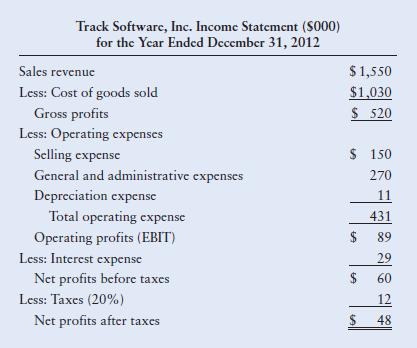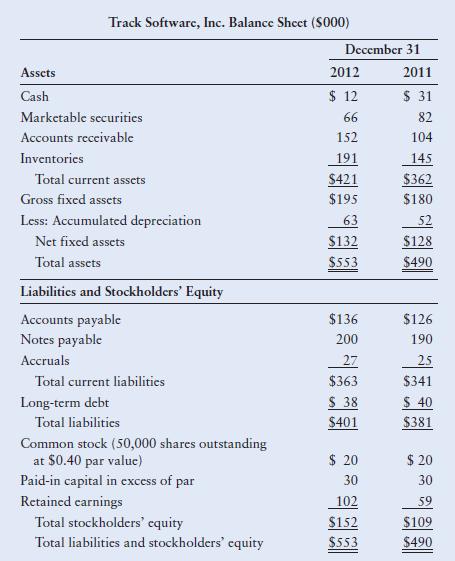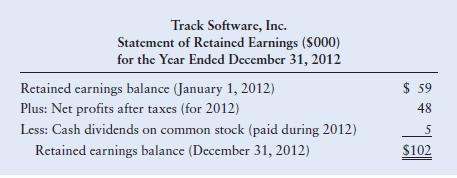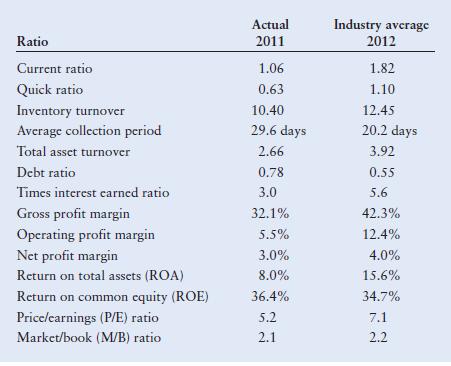Seven years ago, after 15 years in public accounting, Stanley Booker, CPA, resigned his position as manager
Question:
Seven years ago, after 15 years in public accounting, Stanley Booker, CPA, resigned his position as manager of cost systems for Davis, Cohen, and O’Brien Public Accountants and started Track Software, Inc. In the 2 years preceding his departure from Davis, Cohen, and O’Brien, Stanley had spent nights and weekends developing a sophisticated cost-accounting software program that became Track’s initial product offering. As the firm grew, Stanley planned to develop and expand the software product offerings—all of which would be related to streamlining the accounting processes of medium- to large-sized manufacturers.
Although Track experienced losses during its first 2 years of operation—2006 and 2007—its profit has increased steadily from 2008 to the present (2012). The firm’s profit history, including dividend payments and contributions to retained earnings, is summarized in Table 1.
Stanley started the firm with a $100,000 investment—his savings of $50,000 as equity and a $50,000 long-term loan from the bank. He had hoped to maintain his initial 100 percent ownership in the corporation, but after experiencing a $50,000 loss during the first year of operation (2006), he sold 60 percent of the stock to a group of investors to obtain needed funds. Since then, no other stock transactions have taken place. Although he owns only 40 percent of the firm, Stanley actively manages all aspects of its activities; the other stockholders are not active in management
of the firm. The firm’s stock was valued at $4.50 per share in 2011 and at $5.28 per share in 2012.
Table 1:
 Stanley has just prepared the firm’s 2012 income statement, balance sheet, and statement of retained earnings, shown in Tables 2, 3, and 4, along with the 2011 balance sheet. In addition, he has compiled the 2011 ratio values and industry average ratio values for 2012, which are applicable to both 2011 and 2012 and are summarized in Table 5 (on page 218). He is quite pleased to have achieved record earnings of $48,000 in 2012, but he is concerned about the firm’s cash flows. Specifically, he is finding it more and more difficult to pay the firm’s bills in a timely manner and generate cash flows to investors—both creditors and owners. To gain insight into these cash flow problems, Stanley is planning to determine the firm’s 2012 operating cash flow (OCF) and free cash flow (FCF).
Stanley has just prepared the firm’s 2012 income statement, balance sheet, and statement of retained earnings, shown in Tables 2, 3, and 4, along with the 2011 balance sheet. In addition, he has compiled the 2011 ratio values and industry average ratio values for 2012, which are applicable to both 2011 and 2012 and are summarized in Table 5 (on page 218). He is quite pleased to have achieved record earnings of $48,000 in 2012, but he is concerned about the firm’s cash flows. Specifically, he is finding it more and more difficult to pay the firm’s bills in a timely manner and generate cash flows to investors—both creditors and owners. To gain insight into these cash flow problems, Stanley is planning to determine the firm’s 2012 operating cash flow (OCF) and free cash flow (FCF).
Stanley is further frustrated by the firm’s inability to afford to hire a software developer to complete development of a cost estimation package that is believed to have “blockbuster” sales potential. Stanley began development of this package 2 years ago, but the firm’s growing complexity has forced him to devote more of his time to administrative duties, thereby halting the development of this product. Stanley’s reluctance to fill this position stems from his concern that the added $80,000 per year in salary and benefits for the position would certainly lower the firm’s earnings per share (EPS) over the next couple of years. Although the project’s success is in no way guaranteed, Stanley believes that if the money were spent to hire the software developer, the firm’s sales and earnings would significantly rise once the 2- to 3-year development, production, and marketing process was completed.
With all of these concerns in mind, Stanley set out to review the various data to develop strategies that would help to ensure a bright future for Track Software. Stanley believed that as part of this process, a thorough ratio analysis of the firm’s 2012 results would provide important additional insights.
Table 2:

Table 3:

Table 4:

Table 5:

TO DO
a. (1) On what financial goal does Stanley seem to be focusing? Is it the correct
goal? Why or why not?
(2) Could a potential agency problem exist in this firm? Explain.
b. Calculate the firm’s earnings per share (EPS) for each year, recognizing that the number of shares of common stock outstanding has remained unchanged since the firm’s inception. Comment on the EPS performance in view of your response in part a.
c. Use the financial data presented to determine Track’s operating cash flow (OCF) and free cash flow (FCF) in 2012. Evaluate your findings in light of Track’s current cash flow difficulties.
d. Analyze the firm’s financial condition in 2012 as it relates to (1) liquidity,
(2) activity, (3) debt, (4) profitability, and (5) market, using the financial statements provided in Tables 2 and 3 and the ratio data included in Table 5. Be sure to evaluate the firm on both a cross-sectional and a time-series basis.
e. What recommendation would you make to Stanley regarding hiring a new software developer? Relate your recommendation here to your responses in part a.
f. Track Software paid $5,000 in dividends in 2012. Suppose an investor approached Stanley about buying 100% of his firm. If this investor believed that by owning the company he could extract $5,000 per year in cash from the company in perpetuity, what do you think the investor would be willing to pay for the firm if the required return on this investment is 10%?
g. Suppose that you believed that the FCF generated by Track Software in 2012 could continue forever. You are willing to buy the company in order to receive this perpetual stream of free cash flow. What are you willing to pay if you require a 10% return on your investment?
Step by Step Answer:

Principles Of Managerial Finance
ISBN: 978-0136119463
13th Edition
Authors: Lawrence J. Gitman, Chad J. Zutter




